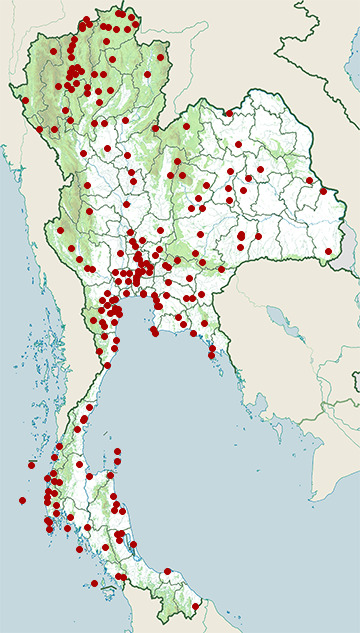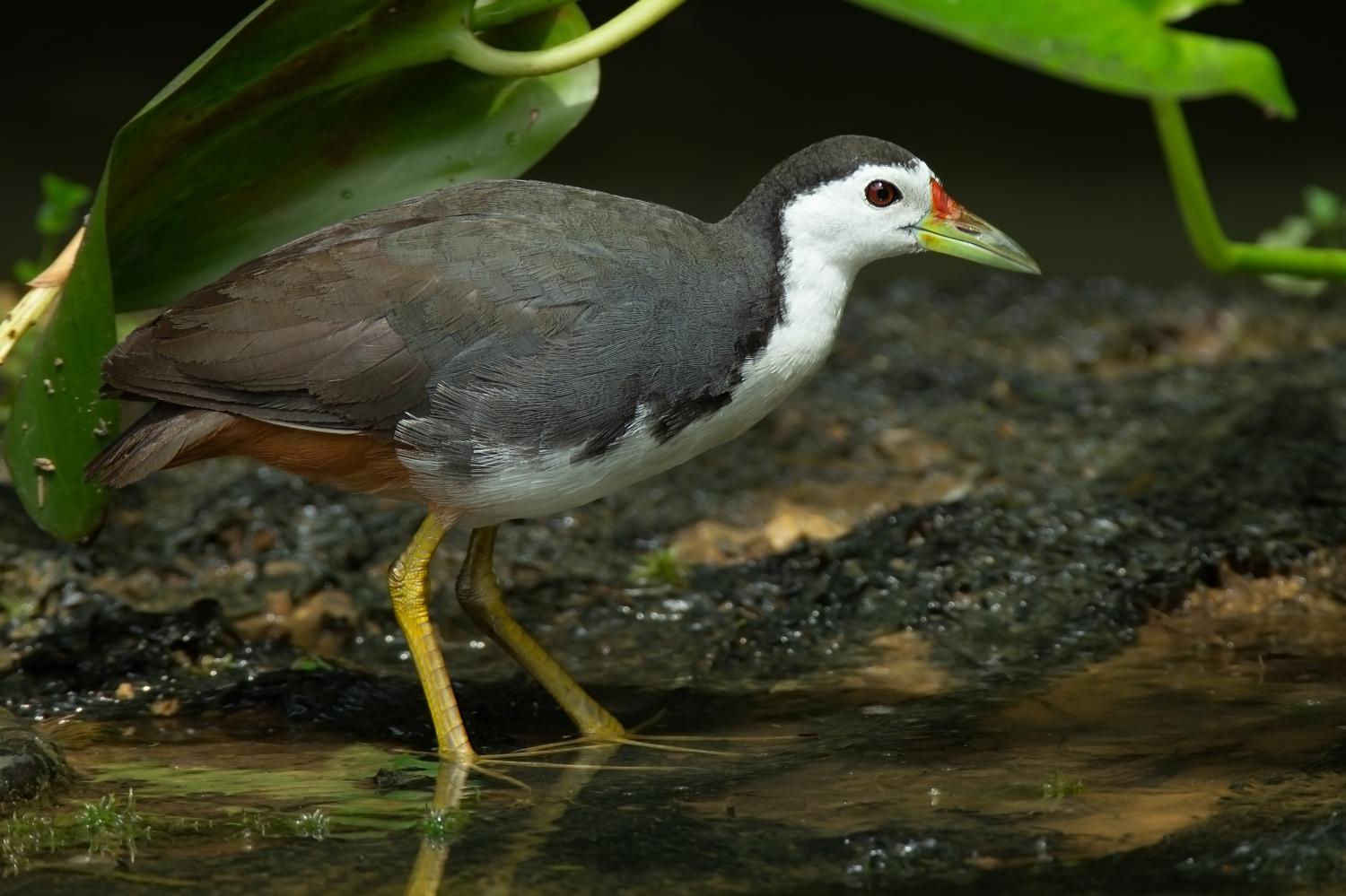Species of Thailand
White-breasted waterhen
Amaurornis phoenicurus
Thomas Pennant, 1769
In Thai: นกกวัก
The white-breasted waterhen (Amaurornis phoenicurus) is a waterbird of the rail and crake family, Rallidae, that is widely distributed across South and Southeast Asia. They are dark slaty birds with a clean white face, breast and belly. They are somewhat bolder than most other rails and are often seen stepping slowly with their tail cocked upright in open marshes or even drains near busy roads. They are largely crepuscular in activity and during the breeding season, just after the first rains, make loud and repetitive croaking calls.
Description
Adult white-breasted waterhens have mainly dark grey upperparts and flanks, and a white face, neck and breast. The lower belly and undertail are cinnamon coloured. The body is flattened laterally to allow easier passage through the reeds or undergrowth. They have long toes, a short tail and a yellow bill and legs. Sexes are similar but females measure slightly smaller. Immature birds are much duller versions of the adults. The downy chicks are black, as with all rails.
Several subspecies are named for the populations that are widely distributed. The nominate subspecies is described from Sri Lanka but is often widened to include chinensis of mainland India and adjoining regions in Asia, west to Arabia and east nearly to Japan. The remaining subspecies are those from islands and include insularis of the Andaman and Nicobar Islands, midnicobaricus of the central Nicobars, leucocephala of Car Nicobar, maldivus of the Maldives, javanicus of Java and leucomelanus of Sulawesi and the Lesser Sundas.
Distribution and habitat
Their breeding habitat is marshes across tropical Asia from Pakistan east to Indonesia. They are mainly seen in the plains but have been known from the higher hills such as in Nainital (1300m) and the High Range (1500m) in Kerala. These large 32 cm long rails are permanent residents throughout their range. They make short distance movements and are known to colonize new areas. They have been noted as some of the early colonizers on the volcanic island of Rakata. Although most often found near freshwater, they are also found near brackish water and even the seashore when there is no freshwater as on the volcanic Barren Island in the Andamans.
Behaviour and ecology
These birds are usually seen singly or in pairs as they forage slowly along the edge of a waterbody mainly on the ground but sometimes clambering up low vegetation. The tail is held up and jerked as they walk. They probe with their bill in mud or shallow water, also picking up food by sight. They mainly eat insects (large numbers of beetles have been recorded), small fish (which are often carefully washed in water), aquatic invertebrates and grains or seeds such as those of Pithecolobium dulce. They may sometimes feed in deeper water in the manner of a moorhen.
The nesting season is mainly June to October but varies locally. They nest in a dry location on the ground in marsh vegetation, laying 6-7 eggs. Courtship involves bowing, billing and nibbling. The eggs hatch in about 19 days. Both sexes incubate the eggs and take care of the chicks. Chicks often dive underwater to escape predation. Adults are said to build a roost or brood nest where young chicks and the adults roost.
Many rails are very secretive, but white-breasted waterhens are often seen out in the open. They can be noisy especially at dawn and dusk, with loud croaky calls. The Andamans population insularis is said to make duck like quack calls.
In culture
Local names of this bird are often formed by onomatopoeia (based on the sound it makes), for example ruak-ruak in Malay and in Sinhala.; although differently formed local names are also not uncommon, such as "Dahuk" in Bengali (used in Bangladesh and the Bengali-speaking areas of India) and "Dauk" (ডাউক) in Assamese. In Odisha it is called as "Daahuka" in Odia (ଡାହୁକ).In maharashtra it is called as "pankombadi"(पाणकोंबडी) or kuak kombadi (कुवाक कोंबडी) in marathi.
The naturalist writer Eha humorously describes the call of this species:
"It began with loud harsh roars which might have been elicited from a bear by roasting it slowly over a large fire, then suddenly changed to a clear note repeated like the coo of a dove."
This article uses material from Wikipedia released under the Creative Commons Attribution-Share-Alike Licence 3.0. Eventual photos shown in this page may or may not be from Wikipedia, please see the license details for photos in photo by-lines.
Category / Seasonal Status
BCST Category: Recorded in an apparently wild state within the last 50 years
BCST Seasonal statuses:
- Resident or presumed resident
- Non-breeding visitor
Scientific classification
- Kingdom
- Animalia
- Phylum
- Chordata
- Class
- Aves
- Order
- Gruiformes
- Family
- Rallidae
- Genus
- Amaurornis
- Species
- Amaurornis phoenicurus
Common names
- Thai: นกกวัก
Synonyms
- Erythra phoenicura
Conservation status

Least Concern (IUCN3.1)
Photos
Please help us review the bird photos if wrong ones are used. We can be reached via our contact us page.
Range Map

- Amphawa District, Samut Songkhram
- Ao Phang-Nga National Park
- Ban Laem District, Phetchaburi
- Ban Lat District, Phetchaburi
- Ban Lueam District, Nakhon Ratchasima
- Ban Phai District, Khon Kaen
- Bang Ban District, Phra Nakhon Si Ayutthaya
- Bang Len District, Nakhon Pathom
- Bang Pa In District, Phra Nakhon Si Ayutthaya
- Bang Pahan District, Phra Nakhon Si Ayutthaya
- Bang Pakong District, Chachoengsao
- Bang Phra Non-Hunting Area
- Bang Pu Recreation Centre
- Bangkok Province
- Borabue District, Maha Sarakham
- Bueng Boraped Non-Hunting Area
- Chae Hom District, Lampang
- Chaiya District, Surat Thani
- Chaiyo District, Ang Thong
- Chatturat District, Chaiyaphum
- Chiang Dao District, Chiang Mai
- Chiang Dao Wildlife Sanctuary
- Chiang Khong District, Chiang Rai
- Chiang Saen District, Chiang Rai
- Doi Inthanon National Park
- Doi Khun Tan National Park
- Doi Lang
- Doi Lo District, Chiang Mai
- Doi Pha Hom Pok National Park
- Doi Phu Kha National Park
- Doi Saket District, Chiang Mai
- Doi Suthep - Pui National Park
- Doi Tao District, Chiang Mai
- Erawan National Park
- Fang District, Chiang Mai
- Hang Chat District, Lampang
- Hua Hin District, Prachuap Khiri Khan
- Huai Chorakhe Mak Reservoir Non-Hunting Area
- Huai Kha Khaeng Wildlife Sanctuary
- Huai Talat Reservoir Non-Hunting Area
- In Buri District, Sing Buri
- Kabin Buri District, Prachinburi
- Kaeng Khoi District, Saraburi
- Kaeng Khro District, Chaiyaphum
- Kaeng Krachan District, Phetchaburi
- Kaeng Krachan National Park
- Kamphaeng Saen District, Nakhon Pathom
- Kantharawichai District, Maha Sarakham
- Kapong District, Phang Nga
- Khanom District, Nakhon Si Thammarat
- Khao Ang Rue Nai Wildlife Sanctuary
- Khao Khiao - Khao Chomphu Wildlife Sanctuary
- Khao Khitchakut National Park
- Khao Laem National Park
- Khao Lak - Lam Ru National Park
- Khao Nang Phanthurat Forest Park
- Khao Phra - Bang Khram Wildlife Sanctuary
- Khao Sam Roi Yot National Park
- Khao Sok National Park
- Khao Yai National Park
- Khao Yoi District, Phetchaburi
- Khemarat District, Ubon Ratchathani
- Khlong Lan National Park
- Khlong Luang District, Pathum Thani
- Khuan Khanun District, Phatthalung
- Khun Tan District, Chiang Rai
- Khung Kraben Non-Hunting Area
- Khura Buri District, Phang Nga
- Klaeng District, Rayong
- Ko Chang National Park
- Ko Lanta National Park
- Ko Phra Thong
- Ko Samui District, Surat Thani
- Kui Buri National Park
- Kumphawapi District, Udon Thani
- Laem Ngop District, Trat
- Laem Pak Bia
- Laem Son National Park
- Lam Nam Kok National Park
- Mae Ai District, Chiang Mai
- Mae Mo District, Lampang
- Mae Moei National Park
- Mae Ping National Park
- Mae Rim District, Chiang Mai
- Mae Taeng District, Chiang Mai
- Mae Tha, Lampang District, Lampang
- Mu Ko Ranong National Park
- Mueang Buriram District, Buriram
- Mueang Chaiyaphum District, Chaiyaphum
- Mueang Chiang Mai District, Chiang Mai
- Mueang Chiang Rai District, Chiang Rai
- Mueang Chonburi District, Chonburi
- Mueang Chumphon District, Chumphon
- Mueang Kalasin District, Kalasin
- Mueang Kanchanaburi District, Kanchanaburi
- Mueang Khon Kaen District, Khon Kaen
- Mueang Krabi District, Krabi
- Mueang Lampang District, Lampang
- Mueang Lamphun District, Lamphun
- Mueang Loei District, Loei
- Mueang Lopburi District, Lopburi
- Mueang Nakhon Nayok District, Nakhon Nayok
- Mueang Nakhon Pathom District, Nakhon Pathom
- Mueang Nakhon Ratchasima District, Nakhon Ratchasima
- Mueang Nakhon Si Thammarat District, Nakhon Si Thammarat
- Mueang Nan District, Nan
- Mueang Nong Khai District, Nong Khai
- Mueang Nonthaburi District, Nonthaburi
- Mueang Pan District, Lampang
- Mueang Pathum Thani District, Pathum Thani
- Mueang Pattani District, Pattani
- Mueang Phang Nga District, Phang Nga
- Mueang Phatthalung District, Phatthalung
- Mueang Phayao District, Phayao
- Mueang Phetchaburi District, Phetchaburi
- Mueang Phichit District, Phichit
- Mueang Phitsanulok District, Phitsanulok
- Mueang Phuket District, Phuket
- Mueang Prachuap Khiri Khan District, Prachuap Khiri Khan
- Mueang Ratchaburi District, Ratchaburi
- Mueang Samut Sakhon District, Samut Sakhon
- Mueang Samut Songkhram District, Samut Songkhram
- Mueang Sukhothai District, Sukhothai
- Mueang Suphanburi District, Suphan Buri
- Mueang Surat Thani District, Surat Thani
- Mueang Surin District, Surin
- Mueang Tak District, Tak
- Mueang Uttaradit District, Uttaradit
- Na Chaluai District, Ubon Ratchathani
- Nam Nao National Park
- Namtok Sam Lan National Park
- Nong Bong Khai Non-Hunting Area
- Nong Plak Phra Ya – Khao Raya Bangsa Non-Hunting
- Nong Song Hong District, Khon Kaen
- Nong Suea District, Pathum Thani
- Nong Ya Plong District, Phetchaburi
- Nong Yai Area Development Project Under Royal Init
- Omkoi Wildlife Sanctuary
- Op Khan National Park
- Pa Sak Chonlasit Dam Non-Hunting Area
- Pa Sang District, Lamphun
- Pai District, Mae Hong Son
- Pak Kret District, Nonthaburi
- Pak Phanang District, Nakhon Si Thammarat
- Pak Phli District, Nakhon Nayok
- Pak Thale
- Pak Tho District, Ratchaburi
- Pathio District, Chumphon
- Pha Daeng National Park
- Phan District, Chiang Rai
- Phanat Nikhom District, Chonburi
- Phi Phi Islands
- Phra Nakhon Si Ayutthaya District, Phra Nakhon Si Ayutthaya
- Phra Phrom District, Nakhon Si Thammarat
- Phu Khiao Wildlife Sanctuary
- Phu Sa Dok Bua National Park
- Phu Suan Sai National Park
- Phutthamonthon District, Nakhon Pathom
- Pran Buri Forest Park
- Ratchasan District, Chachoengsao
- Sai Noi District, Nonthaburi
- Sakaerat Environmental Research Station
- Salak Pra Wildlife Sanctuary
- Salawin National Park
- Samae San Island
- Samut Prakan Province
- San Sai District, Chiang Mai
- Sanam Bin Reservoir Non-Hunting Area
- Sathing Phra District, Songkhla
- Sattahip District, Chonburi
- Sawi District, Chumphon
- Si Satchanalai District, Sukhothai
- Si Satchanalai National Park
- Similan Islands
- Sirinat National Park
- Sri Nakarin Dam National Park
- Sri Phang-nga National Park
- Su-ngai Kolok District, Narathiwat
- Surin Islands
- Ta Phraya National Park
- Takua Pa District, Phang Nga
- Taphan Hin District, Phichit
- Tarutao National Marine Park
- Tat Mok National Park
- Tha Chang District, Sing Buri
- Tha Sala District, Nakhon Si Thammarat
- Tha Takiap District, Chachoengsao
- Tha Yang District, Phetchaburi
- Thai Mueang District, Phang Nga
- Thalang District, Phuket
- Thale Ban National Park
- Thale Noi Non-Hunting Area
- Than Sadet - Koh Pha-Ngan National Park
- Thanyaburi District, Pathum Thani
- Thap Lan National Park
- Wang Chan District, Rayong
- Wang Nam Yen District, Sa Kaeo
- Wang Noi District, Phra Nakhon Si Ayutthaya
- Wat Phai Lom & Wat Ampu Wararam Non-Hunting Area
- Wiang Chai District, Chiang Rai
- Wiang Kaen District, Chiang Rai
- Yan Ta Khao District, Trang

